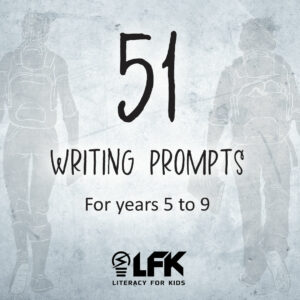Explaining Reading: Inferring
#4. Inferring
Inferring is notoriously difficult for students. The data from our literacy programs consistently show that kids struggle with this concept.
Inferring is the ability to “read between the lines” or to “get the meaning” that the author implies, but does not state directly. No wonder our students find it tricky.
Inferring dominates virtually all comprehension because, to one extent or another, comprehension always involves trying to “get inside the author’s head” to see what he/she meant when the text was composed.
The student, operating from one set of background experience, cannot precisely know the mind of an author, who is coming from a different experience background. The reader must make a calculated guess as to the author’s meaning. Even when the author says something straightforward as “The car was blue,” the reader must infer the shade of blue, the make of the car and so on. So in this sense, virtually all comprehension requires some inference.
Therefore, inferring is a crucial comprehension strategy.
| Inferring is not done carelessly, and it is not wild guessing. Good readers use clues an author supplies plus their own background knowledge. |
How Will You Know You Need to Teach Inferring?
The situation: When discussing the text that has been read, you notice that students cannot answer questions about character traits, or mood or other information the author implies but does not state explicitly.
* Conceptual Understandings That Must Be in Place *Students need to understand:
|
So, what is the “secret” to doing it?
Students must:
- note the clues embedded in the text.
- access their own experience regarding these clues.
- make predictions about the implied meaning based on their experience with the clues provided by the author.
How do you know if your students are successful in this skill?
If after reading or listening to a story, students are able to answer questions that require comprehending what the author has implied but has not directly stated, and see if your students can describe the thinking they did to do such inferring.
Applying it to Writing
Students often understand inferring best if, during their own writing, they are encouraged to imply meaning. Consequently, when teaching to infer during reading, it is a great idea to plan writing sessions in which students are encouraged to insert into their own writing various kinds of implied meaning.
Inferring is essential to comprehension. Our programs Literacy for Kids and Literacy for Boys contain texts that require students to make connections, draw conclusions, or make predictions. When helping a student, pose open-ended questions that require students to infer answers. For example, instead of asking for a direct response, ask questions like “What do you think might happen next?” or “Why do you think the character made that choice?”
Want your students to finish strong in their literacy? Want more from your literacy program? Contact us for a 30-day free trial in your school or classroom. New schools receive this terrific Teaching Resource: 51 Writing Prompts. These are a complete hit with our schools and you will not be disappointed with these image-rich, kid-centred Writing Prompts that will enthuse your writers.




Check out our blogs for more ideas and tips.
Explaining Reading: #3 Imaging
Explaining Reading: #2 Monitoring and Questioning
Explaining Reading: #1 Predicting
7 Parent friendly tips for comprehension
Get boys reading in the digital age
What to do when your son hates reading – 6 top tips
Brought to you by Tanya Grambower

Explaining Reading: Imaging
#3. Imaging
A distinguishing skill of good comprehenders is that they respond to the descriptive text they read. They create pictures, or visual representations, in their minds.
Like so much of comprehension, imaging is something that good readers seem to do “naturally’. To these students, reading is like watching a movie ~ they use their imagination to create a mental representation of characters, settings, events, or concepts described in the text.
Imaging is one of the easier comprehension strategies to teach
Even young children respond to the idea that books are like tv shows and movies in that we should be trying to see and hear what is happening.
Imaging is very important to reading success because it is often the image that makes stories come alive. We want readers to see what the characters see, hear what the characters hear and feel what the characters feel. It is these emotional reactions that often “hook” students and cause them to think that reading is “cool”.
| If we can develop imaging, there is a good chance we can motivate students to make reading a permanent part of their lives. |
How Will You Know You Need to Teach Imaging?
The situation: Students listen to stories being read to them or read stories on their own but do not seem to be emotionally involved in what is happening.
* Conceptual Understandings That Must Be in Place *Students need to understand:
|
So, what is the “secret” to doing it?
Students must:
- Identify words the author is using that are descriptive.
- Use prior knowledge about those words and about our senses to create an image in the mind.
How do you know if your students are successful in this skill?
In listening situations, students should evidence greater emotional involvement in the stories. Students should give tangible indications of excitement, despair, sadness or scariness, depending on what is happening. Into the bargain, when asked, they should be able to describe verbally what they see and hear as they listen (or, for older students, when they read) and the thinking process they used to create the image.
Applying it to Writing
The relationship between reading and writing is particularly clear when teaching imaging. Students should apply their imaging strategy not only when listening and reading, but also when composing their own stories. During those writing opportunities, students should be encouraged to reverse the imaging process. Rather than thinking of imaging from the perspective of a reader trying to figure out what an author is trying to get us to see/hear/feel, students should be encouraged to think about it as a writer trying to get a reader to see or hear or feel.
The more kids practice writing text that helps readers create images, the more skilled they will be at creating images as readers. Our FREE resource for new schools (see below) is closely tied to this skill of imaging. The writing prompts are perfect!
Want your students to finish strong in their literacy? Want more from your literacy program? Contact us for a 30-day free trial in your school or classroom. New schools receive this terrific Teaching Resource: 51 Writing Prompts. These are a complete hit with our schools and you will not be disappointed with these image-rich, kid-centred Writing Prompts that will enthuse your writers.




Check out our blogs for more ideas and tips.
7 Parent friendly tips for comprehension
Get boys reading in the digital age
What to do when your son hates reading – 6 top tips
Brought to you by Tanya Grambower

Explaining Reading: Monitoring and Questioning
#2. Monitoring & Questioning
Comprehension is an active cycle of mental activity. Last week we discussed Predicting ~ but this is only the beginning process of seeking meaning. The cycle continues as students move into the text.
Basically, they monitor, question and, if necessary, they abandon the prediction they made earlier and form new predictions.
Monitoring and Questioning are the Strategic Heart of Comprehension
Monitoring is a process of talking to oneself about whether the meaning being encountered is the meaning anticipated – that is, “Is the prediction I made coming true?” Questioning is a process of talking to oneself about whether the meaning makes sense – that is, “Does this make sense? Is this what I had predicted was going to happen?“
Good readers seem to do it ‘naturally’, however struggling readers often operate under the falsehood that meaning will ‘come to them’ as they decode words.
| This cycle of thinking can be difficult to teach. Predictions are made then must be dismissed and replaced by new predictions. Finally, it takes energy – our students cannot coast along passively. |
How Will You Know You Need to Teach Monitoring, Questioning & Repredicting?
The situation: Students read orally without proper phrasing and intonation. When asked questions about their reading, they guess or do not answer at all.
* Conceptual Understandings That Must Be in Place *Students need to understand:
|
So, what is the “secret” to doing it?
Students must:
- Keep the original prediction in mind.
- Keep questioning whether that prediction continues to make sense as you read new information in the text.
- Use new information in the text and prior knowledge about that information to make new predictions.
How do you know if your students are successful in this skill?
Students will able to share the mental self-talk they did during reading. As an example, they will be able to describe where their monitoring caused them to pause and reconsider, the questions they asked themselves during reading and the times they needed to either modify a prediction or abandon it altogether and create a new one.
Applying it to Writing
This has a direct flow on effect. Students become better writers if they think about how they read. Their writing will make more sense if they are conscious of the monitoring-questioning-re-predicting cycle. After all, this thinking will help minimise the amount of questioning and re-predicting their readers will have to do!
Want your students to finish strong in their literacy? Want more from your literacy program? Contact us for a 30-day free trial in your school or classroom. New schools receive this terrific Teaching Resource: 51 Writing Prompts. These are a complete hit with our schools and you will not be disappointed with these image-rich, kid-centred Writing Prompts that will enthuse your writers.




Check out our blogs for more ideas and tips.
7 Parent friendly tips for comprehension
Get boys reading in the digital age
What to do when your son hates reading – 6 top tips
Brought to you by Tanya Grambower

Explaining Reading: Predicting
#1. Predicting
Predicting is fundamental to comprehension. Good readers anticipate meaning. They do this by predicting what they think is going to happen and by revising their predictions as they read.
Predicting is a skill for all ages – from emergent to high school readers
Emergent readers make predictions as they are listening to stories being read to them. More proficient readers make predictions when they are reading expository text. As a result, predicting can be taught to kids starting school and high schoolers, and it is appropriate in various genres of narrative text as well as various forms of expository text.
As with all comprehension strategies, predicting is based on the thoughtful use of prior knowledge. Readers may look at the pictures or the title or the headings to get an idea of what the topic is.
| This is why we feature short video clips in our program ~ aside from grabbing their interest, it provides students with topic clues to make predictions about the text. |
How Will You Know You Need to Teach Predicting?
The situation: Students keep on reading even when what they are saying no longer makes sense. When asked questions about what they just read, they are unsure.
* Conceptual Understandings That Must Be in Place *Students need to understand:
|
So, what is the “secret” to doing it?
Students must:
- Look for clues to the topic.
- Think about what they already know about the topic.
- On the basis of their prior knowledge, predict what they think will happen.
How do you know if your students are successful in this skill?
In follow-up reading, students will report that they made predictions and will state those predictions. When you ask them how they made their predictions, they should report the topic clues they were using and how they used their prior knowledge about each topic clue to figure out what might happen next.
Applying it to Writing
Remind students that when they write, they are authors. Authors provide topic clues the reader can use to make predictions about what is coming next. So, when they are writing, students should be conscious of the clues they are providing the reader.
Want your students to finish strong in their literacy? Want more from your literacy program? Contact us for a 30-day free trial in your school or classroom. New schools receive this terrific Teaching Resource: 51 Writing Prompts. These are a complete hit with our schools and you will not be disappointed with these image-rich, kid-centred Writing Prompts that will enthuse your writers.




Check out our blogs for more ideas and tips.
7 Parent friendly tips for comprehension
Get boys reading in the digital age
What to do when your son hates reading – 6 top tips
Brought to you by Tanya Grambower
